Filipa Estrela has prolonged been a leading proponent of constructed comics made of unconventional materials. Meandering Realms is an anthology that she edited stout of such comics. Be it woodcuts, clay figures, within the reduction of paper, pyrography on wood, or mixed media, this anthology is a tantalizing be taught for followers of vulgar formal experimentation in comics. The anthology has a mixture of CCS artists and others; some are well-established in the case of cartooning while others essentially ply their exchange in other media.
Initiating with the CCS artists, Issy Manley’s pandemic anecdote about taking walks for pleasure became once performed in within the reduction of paper and embroidery. It’s a ways a most engaging union of construct and reveal, with countless suave formal touches which might perhaps be all in provider to the memoir. Manley’s web page composition, performed mostly in an open-web page layout, is graceful and contains surprising parts. The usage of embroidery to depict center lines on roads became once an inspired component, especially when they loop around. All of it provides context to this meditation on strolling when others would desire to drive.
Bread Tarleton’s facepaint comic literally uses their face for a comic e book in panel after panel, with paint growing photography and lettering. The anecdote is fully absurd, yet Tarleton makes it work so effectively. The anecdote is enticing ample that the gimmick never grows outmoded.
Allison Bannister’s retelling of a Greek delusion with a feminist edge became once performed in layered woodcuts, and this became once an incredibly efficient system of portraying this map of anecdote. Stacking and layering the photography gave them weight and depth, as even when one became once having a explore at a fresco. The sepia tones feel adore the reader is having a explore at something primitive. Bannister’s drawing and decorative touches most productive additional this develop, especially the detail on the tree that is so central to the raze of this delusion about unasked for romantic attention that drives the protagonist to transform into a tree out of defiance.
Yarn Clemmons does a highly expressive anecdote the utilize of clay figures and mixed media. It’s a anecdote about how a beloved childhood family sport became once phased out attributable to the protagonist’s brother’s sensitivity when it comes to his enamel, and it evolves into how no longer figuring out others can lead to fractures.
Estrela contributed two comics. The major became once about an elder seed who selected to pause underground, regardless of being cajoled by the roots around it. It became once pyrography on wood, and the burnt tones mimicked sepia hues. The shading gradations being made by altering the depth of the flame became once fully ingenious. As soon as extra, while the construct became once vital, it became once fully within the provider of reveal. Her other anecdote became once performed with needlefelt and wool, and it became once about an explorer giving a mushroom sentience and what the mushroom chooses to carry out in a while. The muted, fuzzy colours originate an environment fully assorted from her first anecdote.
Of the non-CCS cartoonists, Bryn Ziegler’s re-telling of the anecdote of Orpheus (performed with paint markers on acetate) is the most successful. The sharpness of the colors ride hand-in-hand with the dramatic reveal, growing an achingly graceful location of photography. Kriota Willberg’s anecdote, performed with embroidery on painted cloth, is exclusively in her wheelhouse. It’s about an account of a medical route of after an tried fracture within the 16th century. Willberg nails the medieval tapestry explore. Roshan Ganu’s “Chappal Diary” combines a leather-essentially based sandal and photography; this one is extra a novelty than a coherent memoir. D.T. Burns also uses within the reduction of paper, and while it be much less sophisticated than just a few of the opposite tales, there is a solid gag at the raze. Keren Katz’s utilize of within the reduction of paper and wire sculpture to depict a scene at an art museum is no longer most productive beautifully constructed, it be also a compelling persona look. The opposite items tended to be both too wordy or lacking in substance beyond formal play. Overall, the misses had been factual as vital as the hits. This is indubitably one of the dear rare anthologies where the formal constraints are factual as vital as the memoir reveal, and the items that nailed both made for boldly distinctive and modern comics.






